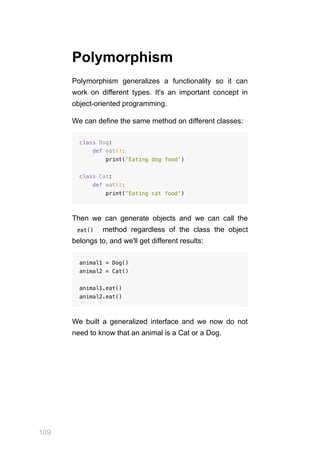python-handbook.pdf
- 2. 1 Table of Contents Introduction Preface Introduction to Python Installing Python Running Python programs Python 2 vs Python 3 The basics of working with Python Data types Operators The Ternary Operator Strings Booleans Numbers Constants Enums User Input Control statements Lists Tuples Dictionaries Sets Functions Objects Loops
- 3. 2 Classes Modules The Python Standard Library The PEP8 Python style guide Debugging Variables scope Accept arguments from the command line Lambda functions Recursion Nested functions Closures Decorators Docstrings Introspection Annotations Exceptions The with statement Installing 3rd party packages using pip List comprehensions Polymorphism Operator Overloading Virtual Environments Conclusion
- 4. 3 Introduction The Python Handbook follows the 80/20 rule: learn 80% of the topic in 20% of the time. I find this approach gives a well-rounded overview. This book does not try to cover everything under the sun related to Python. It focuses on the core of the language, trying to simplify the more complex topics. I hope the contents of this book will help you achieve what you want: learn the basics of Python. This book is written by Flavio. I publish web development tutorials every day on my website flaviocopes.com. You can reach me on Twitter @flaviocopes. Enjoy!
- 5. 4 Introduction to Python Python is literally eating the programming world. It is growing in popularity and usage in ways that are pretty much unprecedented in the history of computers. There is a huge variety of scenarios that Python excels in. Shell scripting, task automation, Web development are just some basic examples. Python is the language of choice for data analysis and machine learning, but it can also adapt to create games and work with embedded devices. Most importantly, it's the language of choice for introductory computer science courses in universities all around the world. Many students learn Python as their first programming language. Many are learning it right now, many will learn it in the future. And for many of them, Python will be the only programming language they need. Thanks to this unique position, Python is likely going to grow even more in the future. The language is simple, expressive, and it's quite straightforward. The ecosystem is huge. There seems to be a library for everything you can imagine. Python is a high-level programming language suitable for beginners thanks to its intuitive syntax, its huge community and vibrant ecosystem.
- 6. 5 It is also appreciated by professionals across many different fields. Technically speaking it is an interpreted language that does not have an intermediate compilation phase like a compiled language, for example C or Java. And like many interpreted languages, it is dynamically typed, which means that you do not have to indicate the types of the variables you use, and variables are not tied to a specific type. This has pros and cons. In particular we can mention that you write programs faster, but on the other hand you have less help from the tools to prevent possible bugs and you will find out about some kinds of issues only by executing the program at runtime. Python supports a wide variety of different programming paradigms, including procedural programming, object oriented programming and functional programming. It's flexible enough to adapt to a lot of different needs. Created in 1991 by Guido van Rossum, it's been rising in popularity - especially in the past 5 years, as this Google Trends infographic shows:
- 7. 6 Starting with Python is very easy. All you need is to install the official package from python.org, for Windows, macOS or Linux, and you're ready to go. If you are new to programming, in the following posts I will guide you to go from zero to becoming a Python programmer. And even if you are currently a programmer specialized into another language, Python is a language worth knowing because I think we're just at the start. Lower level languages like C++ and Rust might be great for expert programmers, but daunting to begin, and they take a long time to master. Python, on the other hand, is a programming language for programmers, of course, but also for the non- programmers. The students, the people doing their day job with Excel, the scientists.
- 8. 7 The language everyone interested in coding should learn first.
- 9. 8 Installing Python Go to https://www.python.org, choose the Downloads menu, choose your operating system and a panel with a link to download the official package will appear: Make sure you follow the specific instructions for your operating system. On macOS you can find a detailed guide on https://flaviocopes.com/python-installation- macos/.
- 10. 9 Running Python programs There are a few different ways to run Python programs. In particular, you have a distinction between using interactive prompts, where you type Python code and it's immediately executed, and saving a Python program into a file, and executing that. Let's start with interactive prompts. If you open your terminal and type python , you will see a screen like this: This is the Python REPL (Read-Evaluate-Print-Loop) Notice the >>> symbol, and the cursor after that. You can type any Python code here, and press the enter key to run it. For example try defining a new variable using name = "Flavio" and then print its value, using print() :
- 11. 10 print(name) Note: in the REPL, you can also just type name , press the enter key and you'll get the value back. But in a program, you are not going to see any output if you do so - you need to use print() instead. Any line of Python you write here is going to be executed immediately. Type quit() to exit this Python REPL. You can access the same interactive prompt using the IDLE application that's installed by Python automatically:
- 12. 11 This might be more convenient for you because with the mouse you can move around and copy/paste more easily than with the terminal. Those are the basics that come with Python by default. However I recommend to install IPython, probably the best command line REPL application you can find. Install it with pip install ipython Make sure the pip binaries are in your path, then run ipython : ipython is another interface to work with a Python REPL, and provides some nice features like syntax highlighting, code completion, and much more. The second way to run a Python program is to write your Python program code into a file, for example program.py :
- 13. 12 and then run it with python program.py Note that we save Python programs with the .py extension, that's a convention. In this case the program is executed as a whole, not one line at a time. And that's typically how we run programs. We use the REPL for quick prototyping and for learning. On Linux and macOS a Python program can also be transformed into a shell script, by prepending all its content with a special line that indicates which executable to use to run it. On my system the Python executable is located in /usr/bin/python3 , so I type #!/usr/bin/python3 in the first line:
- 14. 13 Then I can set execution permission on the file: chmod u+x program.py and I can run the program with ./program.py This is especially useful when you write scripts that interact with the terminal. We have many other ways to run Python programs. One of them is using VS Code, and in particular the official Python extension from Microsoft:
- 15. 14 After installing this extension you will have Python code autocompletion and error checking, automatic formatting and code linting with pylint , and some special commands, including: Python: Start REPL to run the REPL in the integrated terminal: Python: Run Python File in Terminal to run the current file in the terminal:
- 16. 15 Python: Run Current File in Python Interactive Window: and many more. Just open the command palette (View -> Command Palette, or Cmd-Shift-P) and type python to see all the Python-related commands:
- 17. 16 Another way to easily run Python code is to use repl.it, a very nice website that provides a coding environment you can create and run your apps on, in any language, Python included: Signup (it's free), then under "create a repl" click Python:
- 18. 17 and you will be immediately shown an editor with a main.py file, ready to be filled with a lot of Python code: Once you have some code, click "Run" to run it on the right side of the window:
- 19. 18 I think repl.it is handy because: you can easily share code just by sharing the link multiple people can work on the same code it can host long-running programs you can install packages it provides you a key-value database for more complex applications
- 20. 19 Python 2 vs Python 3 One key topic to talk about, right from the start, is the Python 2 vs Python 3 discussion. Python 3 was introduced in 2008, and it's been in development as the main Python version, while Python 2 continued being maintained with bug fixes and security patches until early 2020. On that date, Python 2 support was discontinued. Many programs are still written using Python 2, and organizations still actively work on those, because the migration to Python 3 is not trivial and those programs would require a lot of work to upgrade those programs. And large and important migrations always introduce new bugs. But new code, unless you have to adhere to rules set by your organization that forces Python 2, should always be written in Python 3. This book focuses on Python 3.
- 21. 20 The basics of working with Python Variables We can create a new Python variable by assigning a value to a label, using the = assignment operator. In this example we assign a string with the value "Roger" to the name label: name = "Roger" Here's an example with a number: age = 8 A variable name can be composed by characters, numbers, the _ underscore character. It can't start with a number. These are all valid variable names: name1 AGE aGE a11111 my_name _name These are invalid variable names:
- 22. 21 123 test! name% Other than that, anything is valid unless it's a Python keyword. There are some keywords like for , if , while , import and more. There's no need to memorize them, as Python will alert you if you use one of those as a variable, and you will gradually recognize them as part of the Python programming language syntax. Expressions and statements We can expression any sort of code that returns a value. For example 1 + 1 "Roger" A statement on the other hand is an operation on a value, for example these are 2 statements: name = "Roger" print(name) A program is formed by a series of statements. Each statement is put on its own line, but you can use a semicolon to have more than one statement on a single line:
- 23. 22 name = "Roger"; print(name) Comments In a Python program, everything after a hash mark is ignored, and considered a comment: #this is a commented line name = "Roger" # this is an inline comment Indentation Indentation in Python is meaningful. You cannot indent randomly like this: name = "Flavio" print(name) Some other languages do not have meaningful whitespace, but in Python, indentation matters. In this case, if you try to run this program you would get a IndentationError: unexpected indent error, because indenting has a special meaning. Everything indented belongs to a block, like a control statement or conditional block, or a function or class body. We'll see more about those later on.
- 24. 23 Data types Python has several built-in types. If you create the name variable assigning it the value "Roger", automatically this variable is now representing a String data type. name = "Roger" You can check which type a variable is using the type() function, passing the variable as an argument, and then comparing the result to str : name = "Roger" type(name) == str #True Or using isinstance() : name = "Roger" isinstance(name, str) #True Notice that to see the True value in Python, outside of a REPL, you need to wrap this code inside print() , but for clarity reasons I avoid using it We used the str class here, but the same works for other data types. First, we have numbers. Integer numbers are represented using the int class. Floating point numbers (fractions) are of type float :
- 25. 24 age = 1 type(age) == int #True fraction = 0.1 type(fraction) == float #True You saw how to create a type from a value literal, like this: name = "Flavio" age = 20 Python automatically detects the type from the value type. You can also create a variable of a specific type by using the class constructor, passing a value literal or a variable name: name = str("Flavio") anotherName = str(name) You can also convert from one type to another by using the class constructor. Python will try to determine the correct value, for example extracting a number from a string: age = int("20") print(age) #20 fraction = 0.1 intFraction = int(fraction) print(intFraction) #0
- 26. 25 This is called casting. Of course this conversion might not always work depending on the value passed. If you write test instead of 20 in the above string, you'll get a ValueError: invalid literal for int() with base 10: 'test' error. Those are just the basics of types. We have a lot more types in Python: complex for complex numbers bool for booleans list for lists tuple for tuples range for ranges dict for dictionaries set for sets and more! We'll explore them all soon.
- 27. 26 Operators Python operators are symbols that we use to run operations upon values and variables. We can divide operators based on the kind of operation they perform: assignment operator arithmetic operators comparison operators logical operators bitwise operators plus some interesting ones like is and in . Assignment operator The assignment operator is used to assign a value to a variable: age = 8 Or to assign a variable value to another variable: age = 8 anotherVariable = age Since Python 3.8, the := walrus operator is used to assign a value to a variable as part of another operation. For example inside an if or in the conditional part of a loop. More on that later.
- 28. 27 Arithmetic operators Python has a number of arithmetic operators: + , - , * , / (division), % (remainder), ** (exponentiation) and // (floor division): 1 + 1 #2 2 - 1 #1 2 * 2 #4 4 / 2 #2 4 % 3 #1 4 ** 2 #16 4 // 2 #2 Note that you don't need a space between the operands, but it's good for readability. - also works as a unary minus operator: print(-4) #-4 + is also used to concatenate String values: "Roger" + " is a good dog" #Roger is a good dog We can combine the assignment operator with arithmetic operators: += -= *= /= %= ..and so on
- 29. 28 Example: age = 8 age += 1 # age is now 9 Comparison operators Python defines a few comparison operators: == != > < >= <= You can use those operators to get a boolean value ( True or False ) depending on the result: a = 1 b = 2 a == b #False a != b #True a > b #False a <= b #True Boolean operators Python gives us the following boolean operators: not and or
- 30. 29 When working with True or False attributes, those work like logical AND, OR and NOT, and are often used in the if conditional expression evaluation: condition1 = True condition2 = False not condition1 #False condition1 and condition2 #False condition1 or condition2 #True Otherwise, pay attention to a possible source of confusion. or used in an expression returns the value of the first operand that is not a falsy value ( False , 0 , '' , [] ..). Otherwise it returns the last operand. print(0 or 1) ## 1 print(False or 'hey') ## 'hey' print('hi' or 'hey') ## 'hi' print([] or False) ## 'False' print(False or []) ## '[]' The Python docs describe it as if x is false, then y, else x . and only evaluates the second argument if the first one is true. So if the first argument is falsy ( False , 0 , '' , [] ..), it returns that argument. Otherwise it evaluates the second argument:
- 31. 30 print(0 and 1) ## 0 print(1 and 0) ## 0 print(False and 'hey') ## False print('hi' and 'hey') ## 'hey' print([] and False ) ## [] print(False and [] ) ## False The Python docs describe it as if x is false, then x, else y . Bitwise operators Some operators are used to work on bits and binary numbers: & performs binary AND | performs binary OR ^ performs a binary XOR operation ~ performs a binary NOT operation << shift left operation >> shift right operation Bitwise operators are rarely used, only in very specific situations, but they are worth mentioning. is and in is is called the identity operator. It is used to compare two objects and returns true if both are the same object. More on objects later. in is called the membership operator. Is used to tell if a value is contained in a list, or another sequence. More on lists and other sequences later.
- 32. 31 The Ternary Operator The ternary operator in Python allows you to quickly define a conditional. Let's say you have a function that compares an age variable to the 18 value, and return True or False depending on the result. Instead of writing: def is_adult(age): if age > 18: return True else: return False You can implement it with the ternary operator in this way: def is_adult(age): return True if age > 18 else False First you define the result if the condition is True, then you evaluate the condition, then you define the result if the condition is false: <result_if_true> if <condition> else <result_if_fals
- 33. 32 Strings A string in Python is a series of characters enclosed into quotes or double quotes: "Roger" 'Roger' You can assign a string value to a variable: name = "Roger" You can concatenate two strings using the + operator: phrase = "Roger" + " is a good dog" You can append to a string using += : name = "Roger" name += " is a good dog" print(name) #Roger is a good dog You can convert a number to a string using the str class constructor: str(8) #"8" This is essential to concatenate a number to a string:
- 34. 33 A string can be multi-line when defined with a special syntax, enclosing the string in a set of 3 quotes: print("""Roger is 8 years old """) #double quotes, or single quotes print(''' Roger is 8 years old ''') A string has a set of built-in methods, like: isalpha() to check if a string contains only characters and is not empty isalnum() to check if a string contains characters or digits and is not empty isdecimal() to check if a string contains digits and is not empty lower() to get a lowercase version of a string islower() to check if a string is lowercase upper() to get an uppercase version of a string isupper() to check if a string is uppercase title() to get a capitalized version of a string print("Roger is " + str(8) + " years old") #Roger is
- 35. 34 startsswith() to check if the string starts with a specific substring endswith() to check if the string ends with a specific substring replace() to replace a part of a string split() to split a string on a specific character separator strip() to trim the whitespace from a string join() to append new letters to a string find() to find the position of a substring and many more. None of those methods alter the original string. They return a new, modified string instead. For example: name = "Roger" print(name.lower()) #"roger" print(name) #"Roger" You can use some global functions to work with strings, too. In particular I think of len() , which gives you the length of a string: name = "Roger" print(len(name)) #5 The in operator lets you check if a string contains a substring: name = "Roger" print("ger" in name) #True
- 36. 35 Escaping is a way to add special characters into a string. For example, how do you add a double quote into a string that's wrapped into double quotes? name = "Roger" "Ro"Ger" will not work, as Python will think the string ends at "Ro" . The way to go is to escape the double quote inside the string, with the backslash character: name = "Ro"ger" This applies to single quotes too ' , and for special formatting characters like t for tab, n for new line and for the backslash. Given a string, you can get its characters using square brackets to get a specific item, given its index, starting from 0: name = "Roger" name[0] #'R' name[1] #'o' name[2] #'g' Using a negative number will start counting from the end: name = "Roger" name[-1] #"r"
- 37. 36 You can also use a range, using what we call slicing: name = "Roger" name[0:2] #"Ro" name[:2] #"Ro" name[2:] #"ger"
- 38. 37 Booleans Python provides the bool type, which can have two values: True and False (capitalized) done = False done = True Booleans are especially useful with conditional control structures like if statements: done = True if done: # run some code here else: # run some other code When evaluating a value for True or False , if the value is not a bool we have some rules depending on the type we're checking: numbers are always True unless for the number 0 strings are False only when empty lists, tuples, sets, dictionaries are False only when empty You can check if a value is a boolean in this way: done = True type(done) == bool #True
- 39. 38 Or using isinstance() , passing 2 arguments: the variable, and the bool class: done = True isinstance(done, bool) #True The global any() function is also very useful when working with booleans, as it returns True if any of the values of the iterable (list, for example) passed as argument are True : book_1_read = True book_2_read = False read_any_book = any([book_1_read, book_2_read]) The global all() function is same, but returns True if all of the values passed to it are True : ingredients_purchased = True meal_cooked = False ready_to_serve = all([ingredients_purchased, meal_co
- 40. 39 Numbers Numbers in Python can be of 3 types: int , float and complex . Integer numbers Integer numbers are represented using the int class. You can define an integer using a value literal: age = 8 You can also define an integer number using the int() constructor: age = int(8) To check if a variable is of type int , you can use the type() global function: type(age) == int #True Floating point numbers Floating point numbers (fractions) are of type float . You can define an integer using a value literal: fraction = 0.1 Or using the float() constructor:
- 41. 40 fraction = float(0.1) To check if a variable is of type float , you can use the type() global function: type(fraction) == float #True Complex numbers Complex numbers are of type complex . You can define them using a value literal: complexNumber = 2+3j or using the complex() constructor: complexNumber = complex(2, 3) Once you have a complex number, you can get its real and imaginary part: complexNumber.real #2.0 complexNumber.imag #3.0 Again, to check if a variable is of type complex , you can use the type() global function: type(complexNumber) == complex #True Arithmetic operations on numbers
- 42. 41 You can perform arithmetic operations on numbers, using the arithmetic operators: + , - , * , / (division), % (remainder), ** (exponentiation) and // (floor division): 1 + 1 #2 2 - 1 #1 2 * 2 #4 4 / 2 #2 4 % 3 #1 4 ** 2 #16 4 // 2 #2 and you can use the compound assignment operators += -= *= /= %= ..and so on to quickly perform operations on variables, too: age = 8 age += 1 Built-in Functions There are 2 built-in functions that help with numbers: abs() returns the absolute value of a number. round() given a number, returns its value rounded to the nearest integer:
- 43. 42 round(0.12) #0 You can specify a second parameter to set the decimal points precision: round(0.12, 1) #0.1 Several other math utility functions and constants are provided by the Python standard library: the math package provides general math functions and constants the cmath package provides utilities to work with complex numbers. the decimal package provides utilities to work with decimals and floating point numbers. the fractions package provides utilities to work with rational numbers We'll explore some of those separately later on.
- 44. 43 Constants Python has no way to enforce a variable to be a constant. The nearest you can go is to use an enum: class Constants(Enum): WIDTH = 1024 HEIGHT = 256 And get to each value using for example Constants.WIDTH.value . No one can reassign that value. Otherwise if you want to rely on naming conventions, you can adhere to this one: declare variables that should never change uppercase: WIDTH = 1024 No one will prevent to overwrite this value, and Python will not stop it. That's what does most Python code you will see.
- 45. 44 Enums Enums are readable names that are bound to a constant value. To use enums, import Enum from the enum standard library module: from enum import Enum Then you can initialize a new enum in this way: class State(Enum): INACTIVE = 0 ACTIVE = 1 Once you do so, you can reference State.INACTIVE and State.ACTIVE , and they serve as constants. Now if you try to print State.ACTIVE for example: print(State.ACTIVE) it will not return 1 , but State.ACTIVE . The same value can be reached by the number assigned in the enum: print(State(1)) will return State.ACTIVE . Same for using the square brackets notation State['ACTIVE'] . You can however get the value using State.ACTIVE.value . You can list all the possible values of an enum:
- 46. 45 You can count them: len(State) # 2 list(State) # [<State.INACTIVE: 0>, <State.ACTIVE: 1
- 47. 46 User Input In a Python command line application you can display information to the user using the print() function: name = "Roger" print(name) We can also accept input from the user, using input() : print('What is your age?') age = input() print('Your age is ' + age) This approach gets input at runtime, meaning the program will stop execution and will wait until the user types something and presses the enter key. You can also do more complex input processing and accept input at program invocation time, and we'll see how to do that later on. This works for command line applications. Other kinds of applications will need a different way of accepting input.
- 48. 47 Control statements What's interesting to do with booleans, and expressions that return a boolean in particular, is that we can make decisions and take different roads depending on their True or False value. In Python we do so using the if statement: condition = True if condition == True: # do something When the condition test resolves to True , like in the above case, its block gets executed. What is a block? A block is that part that is indented one level (4 spaces usually) on the right: condition = True if condition == True: print("The condition") print("was true") The block can be formed by a single line, or multiple lines as well, and it ends when you move back to the previous indentation level:
- 49. 48 condition = True if condition == True: print("The condition") print("was true") print("Outside of the if") In combination with if you can have an else block, that's executed if the condition test of if results to False : condition = True if condition == True: print("The condition") print("was True") else: print("The condition") print("was False") And you can have different linked if checks with elif , that's executed if the previous check was False : condition = True name = "Roger" if condition == True: print("The condition") print("was True") elif name == "Roger": print("Hello Roger") else: print("The condition") print("was False")
- 50. 49 The second block in this case is executed if condition is False , and the name variable value is "Roger". In a if statement you can have just one if and else checks, but multiple series of elif checks: condition = True name = "Roger" if condition == True: print("The condition") print("was True") elif name == "Roger": print("Hello Roger") elif name == "Syd": print("Hello Syd") elif name == "Flavio": print("Hello Flavio") else: print("The condition") print("was False") if and else can also be used in an inline format, which lets us return a value or another based on a condition. Example: a = 2 result = 2 if a == 0 else 3 print(result) # 3
- 51. 50 Lists Lists are an essential Python data structure. The allow you to group together multiple values and reference them all with a common name. For example: dogs = ["Roger", "Syd"] A list can hold values of different types: items = ["Roger", 1, "Syd", True] You can check if an item is contained into a list with the in operator: print("Roger" in items) # True A list can also be defined as empty: items = [] You can reference the items in a list by their index, starting from zero: items[0] # "Roger" items[1] # 1 items[3] # True
- 52. 51 Using the same notation you can change the value stored at a specific index: items[0] = "Roger" You can also use the index() method: items.index(0) # "Roger" items.index(1) # 1 As with strings, using a negative index will start searching from the end: items[-1] # True You can also extract a part of a list, using slices: items[0:2] # ["Roger", 1] items[2:] # ["Syd", True] Get the number of items contained in a list using the len() global function, the same we used to get the length of a string: len(items) #4 You can add items to the list by using a list append() method: items.append("Test") or the extend() method:
- 53. 52 items.extend(["Test"]) You can also use the += operator: items += ["Test"] # items is ['Roger', 1, 'Syd', True, 'Test'] Tip: with extend() or += don't forget the square brackets. Don't do items += "Test" or items.extend("Test") or Python will add 4 individual characters to the list, resulting in ['Roger', 1, 'Syd', True, 'T', 'e', 's', 't'] Remove an item using the remove() method: items.remove("Test") You can add multiple elements using items += ["Test1", "Test2"] #or items.extend(["Test1", "Test2"]) These append the item to the end of the list. To add an item in the middle of a list, at a specific index, use the insert() method: items.insert(1, "Test") # add "Test" at index 1
- 54. 53 To add multiple items at a specific index, you need to use slices: items[1:1] = ["Test1", "Test2"] Sort a list using the sort() method: items.sort() Tip: sort() will only work if the list holds values that can be compared. Strings and integers for example can't be compared, and you'll get an error like TypeError: '<' not supported between instances of 'int' and 'str' if you try. The sort() methods orders uppercase letters first, then lowercased letters. To fix this, use: items.sort(key=str.lower) instead. Sorting modifies the original list content. To avoid that, you can copy the list content using itemscopy = items[:] or use the sorted() global function: print(sorted(items, key=str.lower)) that will return a new list, sorted, instead of modifying the original list.
- 55. 54
- 56. 55 Tuples Tuples are another fundamental Python data structure. They allow you to create immutable groups of objects. This means that once a tuple is created, it can't be modified. You can't add or remove items. They are created in a way similar to lists, but using parentheses instead of square brackets: names = ("Roger", "Syd") A tuple is ordered, like a list, so you can get its values referencing an index value: names[0] # "Roger" names[1] # "Syd" You can also use the index() method: items.index("Roger") # 0 items.index("Syd") # 2 As with strings and lists, using a negative index will start searching from the end: names[-1] # True You can count the items in a tuple with the len() function:
- 57. 56 len(names) # 2 You can check if an item is contained into a tuple with the in operator: print("Roger" in names) # True You can also extract a part of a tuple, using slices: names[0:2] # ('Roger', 'Syd') names[1:] # ('Syd',) Get the number of items in a tuple using the len() global function, the same we used to get the length of a string: len(names) #2 You can create a sorted version of a tuple using the sorted() global function: sorted(names) You can create a new tuple from existing tuples using the + operator: newTuple = names + ("Vanille", "Tina")
- 58. 57 Dictionaries Dictionaries are a very important Python data structure. While lists allow you to create collections of values, dictionaries allow you to create collections of key / value pairs. Here is a dictionary example with one key/value pair: dog = { 'name': 'Roger' } The key can be any immutable value like a string, a number or a tuple. The value can be anything you want. A dictionary can contain multiple key/value pairs: dog = { 'name': 'Roger', 'age': 8 } You can access individual key values using this notation: dog['name'] # 'Roger' dog['age'] # 8 Using the same notation you can change the value stored at a specific index: dog['name'] = 'Syd'
- 59. 58 And another way is using the get() method, which has an option to add a default value: dog.get('name') # 'Roger' dog.get('test', 'default') # 'default' The pop() method retrieves the value of a key, and subsequently deletes the item from the dictionary: dog.pop('name') # 'Roger' The popitem() method retrieves and removes the last key/value pair inserted into the dictionary: dog.popitem() You can check if a key is contained into a dictionary with the in operator: 'name' in dog # True Get a list with the keys in a dictionary using the keys() method, passing its result to the list() constructor: list(dog.keys()) # ['name', 'age'] Get the values using the values() method, and the key/value pairs tuples using the items() method:
- 60. 59 print(list(dog.values())) # ['Roger', 8] print(list(dog.items())) # [('name', 'Roger'), ('age', 8)] Get a dictionary length using the len() global function, the same we used to get the length of a string or the items in a list: len(dog) #2 You can add a new key/value pair to the dictionary in this way: dog['favorite food'] = 'Meat' You can remove a key/value pair from a dictionary using the del statement: del dog['favorite food'] To copy a dictionary, use the copy() method: dogCopy = dog.copy()
- 61. 60 Sets Sets are another important Python data structure. We can say they work like tuples, but they are not ordered, and they are mutable. Or we can say they work like dictionaries, but they don't have keys. They also have an immutable version, called frozenset . You can create a set using this syntax: names = {"Roger", "Syd"} Sets work well when you think about them as mathematical sets. You can intersect two sets: set1 = {"Roger", "Syd"} set2 = {"Roger"} intersect = set1 & set2 #{'Roger'} You can create a union of two sets: set1 = {"Roger", "Syd"} set2 = {"Luna"} union = set1 | set2 #{'Syd', 'Luna', 'Roger'} You can get the difference between two sets:
- 62. 61 set1 = {"Roger", "Syd"} set2 = {"Roger"} difference = set1 - set2 #{'Syd'} You can check if a set is a superset of another (and of course if a set is a subset of another) set1 = {"Roger", "Syd"} set2 = {"Roger"} isSuperset = set1 > set2 # True You can count the items in a set with the len() global function: names = {"Roger", "Syd"} len(names) # 2 You can get a list from the items in a set by passing the set to the list() constructor: names = {"Roger", "Syd"} list(names) #['Syd', 'Roger'] You can check if an item is contained into a set with the in operator: print("Roger" in names) # True
- 63. 62 Functions A function lets us create a set of instructions that we can run when needed. Functions are essential in Python and in many other programming languages to create meaningful programs, because they allow us to decompose a program into manageable parts, they promote readability and code reuse. Here is an example function called hello that prints "Hello!": def hello(): print('Hello!') This is the function definition. There is a name ( hello ) and a body, the set of instructions, which is the part that follows the colon and it's indented one level on the right. To run this function, we must call it. This is the syntax to call the function: hello() We can execute this function once, or multiple times. The name of the function, hello , is very important. It should be descriptive, so anyone calling it can imagine what the function does. A function can accept one or more parameters:
- 64. 63 def hello(name): print('Hello ' + name + '!') In this case we call the function passing the argument hello('Roger') We call parameters the values accepted by the function inside the function definition, and arguments the values we pass to the function when we call it. It's common to get confused about this distinction. An argument can have a default value that's applied if the argument is not specified: def hello(name='my friend'): print('Hello ' + name + '!') hello() #Hello my friend! Here's how we can accept multiple parameters: In this case we call the function passing a set of arguments: hello('Roger', 8) def hello(name, age): print('Hello ' + name + ', you are ' + str(age)
- 65. 64 Parameters are passed by reference. All types in Python are objects but some of them are immutable, including integers, booleans, floats, strings, and tuples. This means that if you pass them as parameters and you modify their value inside the function, the new value is not reflected outside of the function: def change(value): value = 2 val = 1 change(val) print(val) #1 If you pass an object that's not immutable, and you change one of its properties, the change will be reflected outside. A function can return a value, using the return statement. For example in this case we return the name parameter name: def hello(name): print('Hello ' + name + '!') return name When the function meets the return statement, the function ends. We can omit the value: def hello(name): print('Hello ' + name + '!') return
- 66. 65 We can have the return statement inside a conditional, which is a common way to end a function if a starting condition is not met: def hello(name): if not name: return print('Hello ' + name + '!') If we call the function passing a value that evaluates to False , like an empty string, the function is terminated before reaching the print() statement. You can return multiple values by using comma separated values: def hello(name): print('Hello ' + name + '!') return name, 'Roger', 8 In this case calling hello('Syd') the return value is a tuple containing those 3 values: ('Syd', 'Roger', 8) .
- 67. 66 Objects Everything in Python is an object. Even values of basic primitive types (integer, string, float..) are objects. Lists are objects, tuples, dictionaries, everything. Objects have attributes and methods that can be accessed using the dot syntax. For example, try defining a new variable of type int : age = 8 age now has access to the properties and methods defined for all int objects. This includes, for example, access to the real and imaginary part of that number: A variable holding a list value has access to a different set of methods: items = [1, 2] items.append(3) items.pop() print(age.real) # 8 print(age.imag) # 0 print(age.bit_length()) #4 # the bit_length() method returns the number of bits
- 68. 67 The methods depend on the type of value. The id() global function provided by Python lets you inspect the location in memory for a particular object. id(age) # 140170065725376 Your memory value will change, I am only showing it as an example If you assign a different value to the variable, its address will change, because the content of the variable has been replaced with another value stored in another location in memory: age = 8 print(id(age)) # 140535918671808 age = 9 print(id(age)) # 140535918671840 But if you modify the object using its methods, the address stays the same: items = [1, 2] print(id(items)) # 140093713593920 items.append(3) print(items) # [1, 2, 3] print(id(items)) # 140093713593920
- 69. 68 The address only changes if you reassign a variable to another value. Some objects are mutable, some are immutable. This depends on the object itself. If the object provides methods to change its content, then it's mutable. Otherwise it's immutable. Most types defined by Python are immutable. For example an int is immutable. There are no methods to change its value. If you increment the value using age = 8 age = age + 1 #or age += 1 and you check with id(age) you will find that age points to a different memory location. The original value has not mutated, we switched to another value.
- 70. 69 Loops Loops are one essential part of programming. In Python we have 2 kinds of loops: while loops and for loops. while loops while loops are defined using the while keyword, and they repeat their block until the condition is evaluated as False : condition = True while condition == True: print("The condition is True") This is an infinite loop. It never ends. Let's halt the loop right after the first iteration: condition = True while condition == True: print("The condition is True") condition = False print("After the loop") In this case, the first iteration is ran, as the condition test is evaluated to True , and at the second iteration the condition test evaluates to False , so the control goes to the next instruction, after the loop.
- 71. 70 It's common to have a counter to stop the iteration after some number of cycles: count = 0 while count < 10: print("The condition is True") count = count + 1 print("After the loop") for loops Using for loops we can tell Python to execute a block for a pre-determined amount of times, up front, and without the need of a separate variable and conditional to check its value. For example we can iterate the items in a list: items = [1, 2, 3, 4] for item in items: print(item) Or, you can iterate a specific amount of times using the range() function: for item in range(04): print(item) range(4) creates a sequence that starts from 0 and contains 4 items: [0, 1, 2, 3] . To get the index, you should wrap the sequence into the enumerate() function:
- 72. 71 items = [1, 2, 3, 4] for index, item in enumerate(items): print(index, item) Break and continue Both while and for loops can be interrupted inside the block, using two special keywords: break and continue . continue stops the current iteration and tells Python to execute the next one. break stops the loop altogether, and goes on with the next instruction after the loop end. The first example here prints 1, 3, 4 . The second example prints 1 : items = [1, 2, 3, 4] for item in items: if item == 2: continue print(item) items = [1, 2, 3, 4] for item in items: if item == 2: break print(item)
- 73. 72 Classes Defining new objects in Python using classes In addition to using the Python-provided types, we can declare our own classes, and from classes we can instantiate objects. An object is an instance of a class. A class is the type of an object. Define a class in this way: class <class_name>: # my class For example let's define a Dog class class Dog: # the Dog class A class can define methods: class Dog: # the Dog class def bark(self): print('WOF!') self as the argument of the method points to the current object instance, and must be specified when defining a method.
- 74. 73 We create an instance of a class, an object, using this syntax: roger = Dog() Now roger is a new object of type Dog. If you run print(type(roger)) You will get <class '__main__.Dog'> A special type of method, __init__() is called constructor, and we can use it to initialize one or more properties when we create a new object from that class: class Dog: # the Dog class def __init__(self, name, age): self.name = name self.age = age def bark(self): print('WOF!') We use it in this way: roger = Dog('Roger', 8) print(roger.name) # 'Roger' print(roger.age) # 8 roger.bark() # 'WOF!' One important features of classes is inheritance.
- 75. 74 We can create an Animal class with a method walk() : class Animal: def walk(self): print('Walking..') and the Dog class can inherit from Animal: class Dog(Animal): def bark(self): print('WOF!') Now creating a new object of class Dog will have the walk() method as that's inherited from Animal : roger = Dog() roger.walk() # 'Walking..' roger.bark() # 'WOF!'
- 76. 75 Modules Every Python file is a module. You can import a module from other files, and that's the base of any program of moderate complexity, as it promotes a sensible organization and code reuse. In the typical Python program, one file acts as the entry point. The other files are modules and expose functions that we can call from other files. The file dog.py contains this code: def bark(): print('WOF!') We can import this function from another file using import , and once we do, we can reference the function using the dot notation, dog.bark() : import dog dog.bark() Or, we can use the from .. import syntax and call the function directly: from dog import bark bark() The first strategy allows us to load everything defined in a file.
- 77. 76 The second strategy lets us pick the things we need. Those modules are specific to your program, and importing depends on the location of the file in the filesystem. Suppose you put dog.py in a lib subfolder. In that folder, you need to create an empty file named __init__.py . This tells Python the folder contains modules. Now you can choose, you can import dog from lib : from lib import dog dog.bark() or you can reference the dog module specific function importing from lib.dog : from lib.dog import bark bark()
- 78. 77 The Python Standard Library Python exposes a lot of built-in functionality through its standard library. The standard library is a huge collection of all sort of utilities, ranging from math utilities to debugging to creating graphical user interfaces. You can find the full list of standard library modules here: https://docs.python.org/3/library/index.html Some of the important modules are: math for math utilities re for regular expressions json to work with JSON datetime to work with dates sqlite3 to use SQLite os for Operating System utilities random for random number generation statistics for statistics utilities requests to perform HTTP network requests http to create HTTP servers urllib to manage URLs Let's introduce how to use a module of the standard library. You already know how to use modules you create, importing from other files in the program folder. Well that's the same with modules provided by the standard library:
- 79. 78 import math math.sqrt(4) # 2.0 or from math import sqrt sqrt(4) # 2.0 We'll soon explore the most important modules individually to understand what we can do with them.
- 80. 79 The PEP8 Python style guide When you write code, you should adhere to the conventions of the programming language you use. If you learn the right naming and formatting conventions right from the start, it will be easier to read code written by other people, and people will find your code easier to read. Python defines its conventions in the PEP8 style guide. PEP stands for Python Enhancement Proposals and it's the place where all Python language enhancements and discussions happen. There are a lot of PEP proposals, all available at https://www.python.org/dev/peps/. PEP8 is one of the first ones, and one of the most important, too. It defines the formatting and also some rules on how to write Python in a "pythonic" way. You can read its full content here: https://www.python.org/dev/peps/pep-0008/ but here's a quick summary of the important points you can start with: Indent using spaces, not tabs Indent using 4 spaces. Python files are encoded in UTF-8 Use maximum 80 columns for your code Write each statement on its own line
- 81. 80 Functions, variable names and file names are lowercase, with underscores between words (snake_case) Class names are capitalized, separate words are written with the capital letter too, (CamelCase) Package names are lowercase and do not have underscores between words Variables that should not change (constants) are written in uppercase Variable names should be meaningful Add useful comments, but avoid obvious comments Add spaces around operators Do not use unnecessary whitespace Add a blank line before a function Add a blank line between methods in a class Inside functions/methods, blank lines can be used to separate related blocks of code to help readability
- 82. 81 Debugging Debugging is one of the best skills you can learn, as it will help you in many difficult situations. Every language has its debugger. Python has pdb , available through the standard library. You debug by adding one breakpoint into your code: breakpoint() You can add more breakpoints if needed. When the Python interpreter hits a breakpoint in your code, it will stop, and it will tell you what is the next instruction it will run. Then and you can do a few things. You can type the name of any variable to inspect its value. You can press n to step to the next line in the current function. If the code calls functions, the debugger does not get into them, and consider them "black boxes". You can press s to step to the next line in the current function. If the next line is a function, the debugger goes into that, and you can then run one instruction of that function at a time. You can press c to continue the execution of the program normally, without the need to do it step-by- step.
- 83. 82 You can press q to stop the execution of the program. Debugging is useful to evaluate the result of an instruction, and it's especially good to know how to use it when you have complex iterations or algorithms that you want to fix.
- 84. 83 Variables scope When you declare a variable, that variable is visible in parts of your program, depending on where you declare it. If you declare it outside of any function, the variable is visible to any code running after the declaration, including functions: age = 8 def test(): print(age) print(age) # 8 test() # 8 We call it a global variable. If you define a variable inside a function, that variable is a local variable, and it is only visible inside that function. Outside the function, it is not reachable: def test(): age = 8 print(age) test() # 8 print(age) # NameError: name 'age' is not defined
- 85. 84 Accept arguments from the command line Python offers several ways to handle arguments passed when we invoke the program from the command line. So far you've run programs either from a REPL, or using python <filename>.py You can pass additional arguments and options when you do so, like this: python <filename>.py <argument1> python <filename>.py <argument1> <argument2> A basic way to handle those arguments is to use the sys module from the standard library. You can get the arguments passed in the sys.argv list: import sys print(len(sys.argv)) print(sys.argv) The sys.argv list contains as the first item the name of the file that was ran, e.g. ['main.py'] .
- 86. 85 This is a simple way, but you have to do a lot of work. You need to validate arguments, make sure their type is correct, you need to print feedback to the user if they are not using the program correctly. Python provides another package in the standard library to help you: argparse . First you import argparse and you call argparse.ArgumentParser() , passing the description of your program: Then you proceed to add arguments you want to accept. For example in this program we accept a -c option to pass a color, like this: python program.py -c red If the argument is not specified, the program raises an error: import argparse parser = argparse.ArgumentParser( description='This program prints the name of my ) import argparse parser = argparse.ArgumentParser( description='This program prints a color HEX val ) parser.add_argument('-c', '--color', metavar='color args = parser.parse_args() print(args.color) # 'red'
- 87. 86 You can set an option to have a specific set of values, using choices : There are more options, but those are the basics. And there are community packages that provide this functionality, too, like Click and Python Prompt Toolkit. ➜ python python program.py usage: program.py [-h] -c color program.py: error: the following arguments are requi parser.add_argument('-c', '--color', metavar='color ➜ python python program.py -c blue usage: program.py [-h] -c color program.py: error: argument -c/--color: invalid choi
- 88. 87 Lambda functions Lambda functions (also called anonymous functions) are tiny functions that have no name and only have one expression as their body. In Python they are defined using the lambda keyword: lambda <arguments> : <expression> The body must be a single expression. Expression, not a statement. This difference is important. An expression returns a value, a statement does not. The simplest example of a lambda function is a function that doubles that value of a number: lambda num : num * 2 Lambda functions can accept more arguments: lambda a, b : a * b Lambda functions cannot be invoked directly, but you can assign them to variables: multiply = lambda a, b : a * b print(multiply(2, 2)) # 4
- 89. 88 The utility of lambda functions comes when combined with other Python functionality, for example in combination with map() , filter() and reduce() .
- 90. 89 Recursion A function in Python can call itself. That's what recursion is. And it can be pretty useful in many scenarios. The common way to explain recursion is by using the factorial calculation. The factorial of a number is the number n mutiplied by n-1 , multiplied by n-2 ... and so on, until reaching the number 1 : 3! = 3 * 2 * 1 = 6 4! = 4 * 3 * 2 * 1 = 24 5! = 5 * 4 * 3 * 2 * 1 = 120 Using recursion we can write a function that calculates the factorial of any number: def factorial(n): if n == 1: return 1 return n * factorial(n-1) print(factorial(3)) # 6 print(factorial(4)) # 24 print(factorial(5)) # 120 If inside the factorial() function you call factorial(n) instead of factorial(n-1) , you are going to cause an infinite recursion. Python by default will halt recursions at 1000 calls, and when this limit is reached, you will get a RecursionError error.
- 91. 90 Recursion is helpful in many places, and it helps us simplify our code when there's no other optimal way to do it, so it's good to know this technique.
- 92. 91 Nested functions Functions in Python can be nested inside other functions. A function defined inside a function is visible only inside that function. This is useful to create utilities that are useful to a function, but not useful outside of it. You might ask: why should I be "hiding" this function, if it does not harm? One, because it's always best to hide functionality that's local to a function, and not useful elsewhere. Also, because we can make use of closures (more on this later). Here is an example: def talk(phrase): def say(word): print(word) words = phrase.split(' ') for word in words: say(word) talk('I am going to buy the milk') If you want to access a variable defined in the outer function from the inner function, you first need to declare it as nonlocal :
- 93. 92 def count(): count = 0 def increment(): nonlocal count count = count + 1 print(count) increment() count() This is useful especially with closures, as we'll see later.
- 94. 93 Closures If you return a nested function from a function, that nested function has access to the variables defined in that function, even if that function is not active any more. Here is a simple counter example. def counter(): count = 0 def increment(): nonlocal count count = count + 1 return count return increment increment = counter() print(increment()) # 1 print(increment()) # 2 print(increment()) # 3 We return the increment() inner function, and that has still access to the state of the count variable even though the counter() function has ended.
- 95. 94 Decorators Decorators are a way to change, enhance or alter in any way how a function works. Decorators are defined with the @ symbol followed by the decorator name, just before the function definition. Example: @logtime def hello(): print('hello!') This hello function has the logtime decorator assigned. Whenever we call hello() , the decorator is going to be called. A decorator is a function that takes a function as a parameter, wraps the function in an inner function that performs the job it has to do, and returns that inner function. In other words: def logtime(func): def wrapper(): # do something before val = func() # do something after return val return wrapper
- 96. 95 Docstrings Documentation is hugely important, not just to communicate to other people what is the goal of a function/class/method/module, but also to yourself. When you'll come back to your code 6 or 12 months from now, you might not remember all the knowledge you are holding in your head, and reading your code and understanding what it is supposed to do, will be much more difficult. Comments are one way to do so: # this is a comment num = 1 #this is another comment Another way is to use docstrings. The utility of docstrings is that they follow conventions and as such they can be processed automatically. This is how you define a docstring for a function: def increment(n): """Increment a number""" return n + 1 This is how you define a docstring for a class and a method:
- 97. 96 class Dog: """A class representing a dog""" def __init__(self, name, age): """Initialize a new dog""" self.name = name self.age = age def bark(self): """Let the dog bark""" print('WOF!') Document a module by placing a docstring at the top of the file, for example supposing this is dog.py : Docstrings can span over multiple lines: """Dog module This module does ... bla bla bla and provides the fo - Dog ... """ class Dog: """A class representing a dog""" def __init__(self, name, age): """Initialize a new dog""" self.name = name self.age = age def bark(self): """Let the dog bark""" print('WOF!')
- 98. 97 def increment(n): """Increment a number """ return n + 1 Python will process those and you can use the help() global function to get the documentation for a class/method/function/module. For example calling help(increment) will give you this: Help on function increment in module __main__: increment(n) Increment a number There are many different standards to format docstrings, and you can choose to adhere to your favorite one. I like Google's standard: https://github.com/google/styleguide/blob/gh- pages/pyguide.md#38-comments-and-docstrings Standard allows to have tools to extract docstrings and automatically generate documentation for your code.
- 99. 98 Introspection Functions, variables and objects can be analyzed using introspection. First, using the help() global function we can get the documentation if provided in form of docstrings. Then, you can use print() to get information about a function: def increment(n): return n + 1 print(increment) # <function increment at 0x7f420e2973a0> or an object: class Dog(): def bark(self): print('WOF!') roger = Dog() print(roger) # <__main__.Dog object at 0x7f42099d3340> The type() function gives us the type of an object:
- 100. 99 print(type(increment)) # <class 'function'> print(type(roger)) # <class '__main__.Dog'> print(type(1)) # <class 'int'> print(type('test')) # <class 'str'> The dir() global function lets us find out all the methods and attributes of an object: The id() global function shows us the location in memory of any object: print(id(roger)) # 140227518093024 print(id(1)) # 140227521172384 It can be useful to check if two variables point to the same object. The inspect standard library module gives us more tools to get information about objects, and you can check it out here: https://docs.python.org/3/library/inspect.html print(dir(roger)) # ['__class__', '__delattr__', '__dict__', '__dir__
- 101. 100 Annotations Python is dynamically typed. We do not have to specify the type of a variable or function parameter, or a function return value. Annotations allow us to (optionally) do that. This is a function without annotations: def increment(n): return n + 1 This is the same function with annotations: def increment(n: int) -> int: return n + 1 You can also annotate variables: count: int = 0 Python will ignore those annotations. A separate tool called mypy can be run standalone, or integrated by IDE like VS Code or PyCharm to automatically check for type errors statically, while you are coding, and it will help you catch type mismatch bugs before even running the code. A great help especially when your software becomes large and you need to refactor your code.
- 102. 101 Exceptions It's important to have a way to handle errors. Python gives us exception handling. If you wrap lines of code into a try: block: try: # some lines of code If an error occurs, Python will alert you and you can determine which kind of error occurred using a except blocks: try: # some lines of code except <ERROR1>: # handler <ERROR1> except <ERROR2>: # handler <ERROR2> To catch all exceptions you can use except without any error type: try: # some lines of code except <ERROR1>: # handler <ERROR1> except: # catch all other exceptions The else block is ran if no exceptions were found:
- 103. 102 A finally block lets you perform some operation in any case, regardless if an error occurred or not The specific error that's going to occur depends on the operation you're performing. For example if you are reading a file, you might get an EOFError . If you divide a number by zero you will get a ZeroDivisionError . If you have a type conversion issue you might get a TypeError . Try this code: result = 2 / 0 print(result) The program will terminate with an error try: # some lines of code except <ERROR1>: # handler <ERROR1> except <ERROR2>: # handler <ERROR2> else: # no exceptions were raised, the code ran succes try: # some lines of code except <ERROR1>: # handler <ERROR1> except <ERROR2>: # handler <ERROR2> else: # no exceptions were raised, the code ran succes finally: # do something in any case
- 104. 103 Traceback (most recent call last): File "main.py", line 1, in <module> result = 2 / 0 ZeroDivisionError: division by zero and the lines of code after the error will not be executed. Adding that operation in a try: block lets us recover gracefully and move on with the program: try: result = 2 / 0 except ZeroDivisionError: print('Cannot divide by zero!') finally: result = 1 print(result) # 1 You can raise exceptions in your own code, too, using the raise statement: raise Exception('An error occurred!') This raises a general exception, and you can intercept it using: try: raise Exception('An error occurred!') except Exception as error: print(error) You can also define your own exception class, extending from Exception:
- 105. 104 class DogNotFoundException(Exception): pass pass here means "nothing" and we must use it when we define a class without methods, or a function without code, too. try: raise DogNotFoundException() except DogNotFoundException: print('Dog not found!')
- 106. 105 The with statement The with statement is very helpful to simplify working with exception handling. For example when working with files, each time we open a file, we must remember to close it. with makes this process transparent. Instead of writing: filename = '/Users/flavio/test.txt' try: file = open(filename, 'r') content = file.read() print(content) finally: file.close() You can write: filename = '/Users/flavio/test.txt' with open(filename, 'r') as file: content = file.read() print(content) In other words we have built-in implicit exception handling, as close() will be called automatically for us. with is not just helpful to work with files. The above example is just meant to introduce its capabilities.
- 107. 106 Installing 3rd party packages using pip The Python standard library contains a huge number of utilities that simplify our Python development needs, but nothing can satisfy everything. That's why individuals and companies create packages, and make them available as open source software for the entire community. Those modules are all collected in a single place, the Python Package Index available at https://pypi.org, and they can be installed on your system using pip . There are more than 270.000 packages freely available, at the time of writing. You should have pip already installed if you followed the Python installation instructions. Install any package using the command pip install : pip install <package> or, if you do have troubles, you can also run it through python -m : python -m pip install <package> For example you can install the requests package, a popular HTTP library:
- 108. 107 pip install requests and once you do, it will be available for all your Python scripts, because packages are installed globally. The exact location depends on your operating system. On macOS, running Python 3.9, the location is /Library/Frameworks/Python.framework/Versions/3.9/li b/python3.9/site-packages . Upgrade a package to its latest version using: pip install –U <package> Install a specific version of a package using: pip install <package>==<version> Uninstall a package using: pip uninstall <package> Show an installed package details, including version, documentation website and author information using: pip show <package>
- 109. 108 List comprehensions List comprehensions are a way to create lists in a very concise way. Suppose you have a list: numbers = [1, 2, 3, 4, 5] You can create a new list using a list comprehension, composed by the numbers list elements, power 2: numbers_power_2 = [n**2 for n in numbers] # [1, 4, 9, 16, 25] List comprehensions are a syntax that's sometimes preferred over loops, as it's more readable when the operation can be written on a single line: numbers_power_2 = [] for n in numbers: numbers_power_2.append(n**2) and over map() : numbers_power_2 = list(map(lambda n : n**2, numbers)
- 110. 109 Polymorphism Polymorphism generalizes a functionality so it can work on different types. It's an important concept in object-oriented programming. We can define the same method on different classes: class Dog: def eat(): print('Eating dog food') class Cat: def eat(): print('Eating cat food') Then we can generate objects and we can call the eat() method regardless of the class the object belongs to, and we'll get different results: animal1 = Dog() animal2 = Cat() animal1.eat() animal2.eat() We built a generalized interface and we now do not need to know that an animal is a Cat or a Dog.
- 111. 110 Operator Overloading Operator overloading is an advanced technique we can use to make classes comparable and to make them work with Python operators. Let's take a class Dog: class Dog: # the Dog class def __init__(self, name, age): self.name = name self.age = age Let's create 2 Dog objects: roger = Dog('Roger', 8) syd = Dog('Syd', 7) We can use operator overloading to add a way to compare those 2 objects, based on the age property: Now if you try running print(roger > syd) you will get the result True . In the same way we defined __gt__() (which means greater than), we can define the following methods: class Dog: # the Dog class def __init__(self, name, age): self.name = name self.age = age def __gt__(self, other): return True if self.age > other.age else Fal
- 112. 111 __eq__() to check for equality __lt__() to check if an object should be considered lower than another with the < operator __le__() for lower or equal ( <= ) __ge__() for greater or equal ( >= ) __ne__() for not equal ( != ) Then you have methods to interoperate with arithmetic operations: __add__() respond to the + operator __sub__() respond to the – operator __mul__() respond to the * operator __truediv__() respond to the / operator __floordiv__() respond to the // operator __mod__() respond to the % operator __pow__() respond to the ** operator __rshift__() respond to the >> operator __lshift__() respond to the << operator __and__() respond to the & operator __or__() respond to the | operator __xor__() respond to the ^ operator There are a few more methods to work with other operators, but you got the idea.
- 113. 112 Virtual Environments It's common to have multiple Python applications running on your system. When applications require the same module, at some point you will reach a tricky situation where an app needs a version of a module, and another app a different version of that same module. To solve this, you use virtual environments. We'll use venv . Other tools work similarly, like pipenv . Create a virtual environment using python -m venv .venv in the folder where you want to start the project, or where you already have an existing project. Then run source .venv/bin/activate Use source .venv/bin/activate.fish on the Fish shell Executing the program will activate the Python virtual environment. Depending on your configuration you might also see your terminal prompt change. Mine changed from
- 114. 113 ➜ folder to (.venv) ➜ folder Now running pip will use this virtual environment instead of the global environment.
- 115. 114 Conclusion Thanks a lot for reading this book. I hope it will inspire you to know more about Python. For more on Python and programming in general, check out my blog flaviocopes.com. Send any feedback, errata or opinions at [email protected]













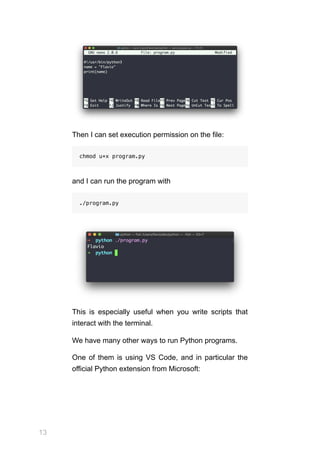










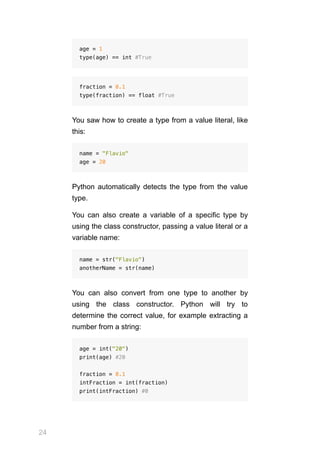


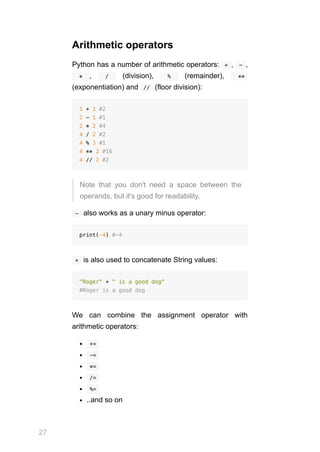
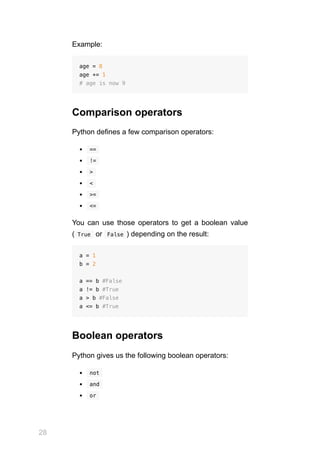
![29
When working with True or False attributes, those
work like logical AND, OR and NOT, and are often
used in the
if conditional expression evaluation:
condition1 = True
condition2 = False
not condition1 #False
condition1 and condition2 #False
condition1 or condition2 #True
Otherwise, pay attention to a possible source of
confusion.
or used in an expression returns the value of the
first operand that is not a falsy value ( False , 0 ,
'' ,
[] ..). Otherwise it returns the last operand.
print(0 or 1) ## 1
print(False or 'hey') ## 'hey'
print('hi' or 'hey') ## 'hi'
print([] or False) ## 'False'
print(False or []) ## '[]'
The Python docs describe it as if x is false, then
y, else x .
and only evaluates the second argument if the first
one is true. So if the first argument is falsy ( False ,
0 , '' , [] ..), it returns that argument. Otherwise it
evaluates the second argument:](https://image.slidesharecdn.com/python-handbook-220701181500-e6d7d68d/85/python-handbook-pdf-30-320.jpg)
![30
print(0 and 1) ## 0
print(1 and 0) ## 0
print(False and 'hey') ## False
print('hi' and 'hey') ## 'hey'
print([] and False ) ## []
print(False and [] ) ## False
The Python docs describe it as if x is false, then
x, else y .
Bitwise operators
Some operators are used to work on bits and binary
numbers:
& performs binary AND
| performs binary OR
^ performs a binary XOR operation
~ performs a binary NOT operation
<< shift left operation
>> shift right operation
Bitwise operators are rarely used, only in very specific
situations, but they are worth mentioning.
is and
in
is is called the identity operator. It is used to
compare two objects and returns true if both are the
same object. More on objects later.
in is called the membership operator. Is used to
tell if a value is contained in a list, or another
sequence. More on lists and other sequences later.](https://image.slidesharecdn.com/python-handbook-220701181500-e6d7d68d/85/python-handbook-pdf-31-320.jpg)

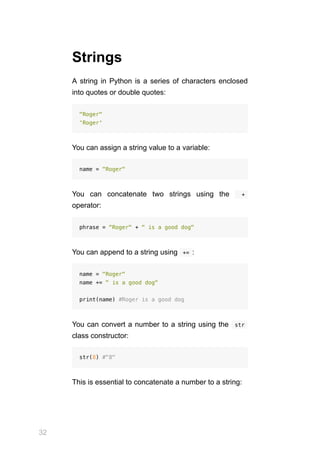
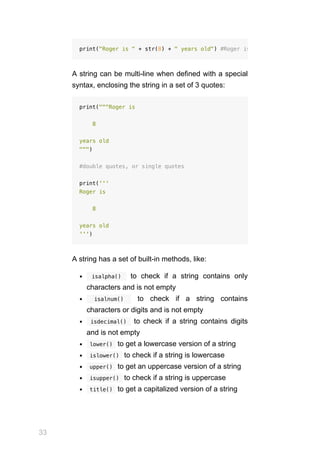

![35
Escaping is a way to add special characters into a
string.
For example, how do you add a double quote into a
string that's wrapped into double quotes?
name = "Roger"
"Ro"Ger" will not work, as Python will think the string
ends at
"Ro" .
The way to go is to escape the double quote inside the
string, with the
backslash character:
name = "Ro"ger"
This applies to single quotes too ' , and for special
formatting characters like
t for tab,
n for new line
and
for the backslash.
Given a string, you can get its characters using square
brackets to get a specific item, given its index, starting
from 0:
name = "Roger"
name[0] #'R'
name[1] #'o'
name[2] #'g'
Using a negative number will start counting from the
end:
name = "Roger"
name[-1] #"r"](https://image.slidesharecdn.com/python-handbook-220701181500-e6d7d68d/85/python-handbook-pdf-36-320.jpg)
![36
You can also use a range, using what we call slicing:
name = "Roger"
name[0:2] #"Ro"
name[:2] #"Ro"
name[2:] #"ger"](https://image.slidesharecdn.com/python-handbook-220701181500-e6d7d68d/85/python-handbook-pdf-37-320.jpg)

![38
Or using isinstance() , passing 2 arguments: the
variable, and the
bool class:
done = True
isinstance(done, bool) #True
The global any() function is also very useful when
working with booleans, as it returns
True if any of the
values of the iterable (list, for example) passed as
argument are
True :
book_1_read = True
book_2_read = False
read_any_book = any([book_1_read, book_2_read])
The global
all() function is same, but returns True
if all of the values passed to it are
True :
ingredients_purchased = True
meal_cooked = False
ready_to_serve = all([ingredients_purchased, meal_co](https://image.slidesharecdn.com/python-handbook-220701181500-e6d7d68d/85/python-handbook-pdf-39-320.jpg)



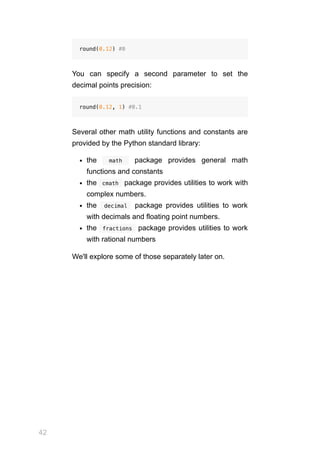

![44
Enums
Enums are readable names that are bound to a
constant value.
To use enums, import Enum from the enum standard
library module:
from enum import Enum
Then you can initialize a new enum in this way:
class State(Enum):
INACTIVE = 0
ACTIVE = 1
Once you do so, you can reference State.INACTIVE
and
State.ACTIVE , and they serve as constants.
Now if you try to print
State.ACTIVE for example:
print(State.ACTIVE)
it will not return
1 , but
State.ACTIVE .
The same value can be reached by the number
assigned in the enum: print(State(1)) will return
State.ACTIVE . Same for using the square brackets
notation
State['ACTIVE'] .
You can however get the value using
State.ACTIVE.value .
You can list all the possible values of an enum:](https://image.slidesharecdn.com/python-handbook-220701181500-e6d7d68d/85/python-handbook-pdf-45-320.jpg)




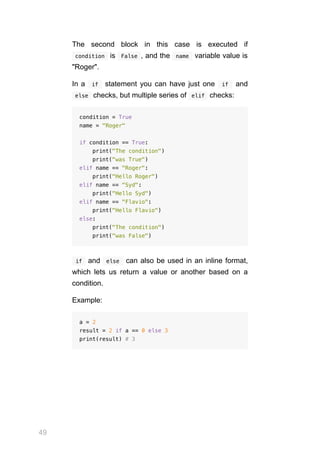
![50
Lists
Lists are an essential Python data structure.
The allow you to group together multiple values and
reference them all with a common name.
For example:
dogs = ["Roger", "Syd"]
A list can hold values of different types:
items = ["Roger", 1, "Syd", True]
You can check if an item is contained into a list with
the
in operator:
print("Roger" in items) # True
A list can also be defined as empty:
items = []
You can reference the items in a list by their index,
starting from zero:
items[0] # "Roger"
items[1] # 1
items[3] # True](https://image.slidesharecdn.com/python-handbook-220701181500-e6d7d68d/85/python-handbook-pdf-51-320.jpg)
![51
Using the same notation you can change the value
stored at a specific index:
items[0] = "Roger"
You can also use the
index() method:
items.index(0) # "Roger"
items.index(1) # 1
As with strings, using a negative index will start
searching from the end:
items[-1] # True
You can also extract a part of a list, using slices:
items[0:2] # ["Roger", 1]
items[2:] # ["Syd", True]
Get the number of items contained in a list using the
len() global function, the same we used to get the
length of a string:
len(items) #4
You can add items to the list by using a list append()
method:
items.append("Test")
or the extend() method:](https://image.slidesharecdn.com/python-handbook-220701181500-e6d7d68d/85/python-handbook-pdf-52-320.jpg)
![52
items.extend(["Test"])
You can also use the
+= operator:
items += ["Test"]
# items is ['Roger', 1, 'Syd', True, 'Test']
Tip: with
extend() or += don't forget the square
brackets. Don't do items += "Test" or
items.extend("Test") or Python will add 4
individual characters to the list, resulting in
['Roger', 1, 'Syd', True, 'T', 'e', 's', 't']
Remove an item using the
remove() method:
items.remove("Test")
You can add multiple elements using
items += ["Test1", "Test2"]
#or
items.extend(["Test1", "Test2"])
These append the item to the end of the list.
To add an item in the middle of a list, at a specific
index, use the
insert() method:
items.insert(1, "Test") # add "Test" at index 1](https://image.slidesharecdn.com/python-handbook-220701181500-e6d7d68d/85/python-handbook-pdf-53-320.jpg)
![53
To add multiple items at a specific index, you need to
use slices:
items[1:1] = ["Test1", "Test2"]
Sort a list using the
sort() method:
items.sort()
Tip: sort() will only work if the list holds values that
can be compared. Strings and integers for
example can't be compared, and you'll get an
error like TypeError: '<' not supported between
instances of 'int' and 'str' if you try.
The sort() methods orders uppercase letters first,
then lowercased letters. To fix this, use:
items.sort(key=str.lower)
instead.
Sorting modifies the original list content. To avoid that,
you can copy the list content using
itemscopy = items[:]
or use the
sorted() global function:
print(sorted(items, key=str.lower))
that will return a new list, sorted, instead of modifying
the original list.](https://image.slidesharecdn.com/python-handbook-220701181500-e6d7d68d/85/python-handbook-pdf-54-320.jpg)

![55
Tuples
Tuples are another fundamental Python data structure.
They allow you to create immutable groups of objects.
This means that once a tuple is created, it can't be
modified. You can't add or remove items.
They are created in a way similar to lists, but using
parentheses instead of square brackets:
names = ("Roger", "Syd")
A tuple is ordered, like a list, so you can get its values
referencing an index value:
names[0] # "Roger"
names[1] # "Syd"
You can also use the
index() method:
items.index("Roger") # 0
items.index("Syd") # 2
As with strings and lists, using a negative index will
start searching from the end:
names[-1] # True
You can count the items in a tuple with the len()
function:](https://image.slidesharecdn.com/python-handbook-220701181500-e6d7d68d/85/python-handbook-pdf-56-320.jpg)
![56
len(names) # 2
You can check if an item is contained into a tuple with
the
in operator:
print("Roger" in names) # True
You can also extract a part of a tuple, using slices:
names[0:2] # ('Roger', 'Syd')
names[1:] # ('Syd',)
Get the number of items in a tuple using the len()
global function, the same we used to get the length of
a string:
len(names) #2
You can create a sorted version of a tuple using the
sorted() global function:
sorted(names)
You can create a new tuple from existing tuples using
the
+ operator:
newTuple = names + ("Vanille", "Tina")](https://image.slidesharecdn.com/python-handbook-220701181500-e6d7d68d/85/python-handbook-pdf-57-320.jpg)
![57
Dictionaries
Dictionaries are a very important Python data
structure.
While lists allow you to create collections of values,
dictionaries allow you to create collections of key /
value pairs.
Here is a dictionary example with one key/value pair:
dog = { 'name': 'Roger' }
The key can be any immutable value like a string, a
number or a tuple. The value can be anything you
want.
A dictionary can contain multiple key/value pairs:
dog = { 'name': 'Roger', 'age': 8 }
You can access individual key values using this
notation:
dog['name'] # 'Roger'
dog['age'] # 8
Using the same notation you can change the value
stored at a specific index:
dog['name'] = 'Syd'](https://image.slidesharecdn.com/python-handbook-220701181500-e6d7d68d/85/python-handbook-pdf-58-320.jpg)
![58
And another way is using the get() method, which
has an option to add a default value:
dog.get('name') # 'Roger'
dog.get('test', 'default') # 'default'
The pop() method retrieves the value of a key, and
subsequently deletes the item from the dictionary:
dog.pop('name') # 'Roger'
The popitem() method retrieves and removes the
last key/value pair inserted into the dictionary:
dog.popitem()
You can check if a key is contained into a dictionary
with the
in operator:
'name' in dog # True
Get a list with the keys in a dictionary using the
keys() method, passing its result to the list()
constructor:
list(dog.keys()) # ['name', 'age']
Get the values using the values() method, and the
key/value pairs tuples using the
items() method:](https://image.slidesharecdn.com/python-handbook-220701181500-e6d7d68d/85/python-handbook-pdf-59-320.jpg)
![59
print(list(dog.values()))
# ['Roger', 8]
print(list(dog.items()))
# [('name', 'Roger'), ('age', 8)]
Get a dictionary length using the len() global
function, the same we used to get the length of a
string or the items in a list:
len(dog) #2
You can add a new key/value pair to the dictionary in
this way:
dog['favorite food'] = 'Meat'
You can remove a key/value pair from a dictionary
using the
del statement:
del dog['favorite food']
To copy a dictionary, use the copy() method:
dogCopy = dog.copy()](https://image.slidesharecdn.com/python-handbook-220701181500-e6d7d68d/85/python-handbook-pdf-60-320.jpg)

![61
set1 = {"Roger", "Syd"}
set2 = {"Roger"}
difference = set1 - set2 #{'Syd'}
You can check if a set is a superset of another (and of
course if a set is a subset of another)
set1 = {"Roger", "Syd"}
set2 = {"Roger"}
isSuperset = set1 > set2 # True
You can count the items in a set with the len()
global function:
names = {"Roger", "Syd"}
len(names) # 2
You can get a list from the items in a set by passing
the set to the
list() constructor:
names = {"Roger", "Syd"}
list(names) #['Syd', 'Roger']
You can check if an item is contained into a set with
the
in operator:
print("Roger" in names) # True](https://image.slidesharecdn.com/python-handbook-220701181500-e6d7d68d/85/python-handbook-pdf-62-320.jpg)




![66
Objects
Everything in Python is an object.
Even values of basic primitive types (integer, string,
float..) are objects. Lists are objects, tuples,
dictionaries, everything.
Objects have attributes and methods that can be
accessed using the dot syntax.
For example, try defining a new variable of type
int :
age = 8
age now has access to the properties and methods
defined for all
int objects.
This includes, for example, access to the real and
imaginary part of that number:
A variable holding a list value has access to a different
set of methods:
items = [1, 2]
items.append(3)
items.pop()
print(age.real) # 8
print(age.imag) # 0
print(age.bit_length()) #4
# the bit_length() method returns the number of bits](https://image.slidesharecdn.com/python-handbook-220701181500-e6d7d68d/85/python-handbook-pdf-67-320.jpg)
![67
The methods depend on the type of value.
The
id() global function provided by Python lets you
inspect the location in memory for a particular object.
id(age) # 140170065725376
Your memory value will change, I am only
showing it as an example
If you assign a different value to the variable, its
address will change, because the content of the
variable has been replaced with another value stored
in another location in memory:
age = 8
print(id(age)) # 140535918671808
age = 9
print(id(age)) # 140535918671840
But if you modify the object using its methods, the
address stays the same:
items = [1, 2]
print(id(items)) # 140093713593920
items.append(3)
print(items) # [1, 2, 3]
print(id(items)) # 140093713593920](https://image.slidesharecdn.com/python-handbook-220701181500-e6d7d68d/85/python-handbook-pdf-68-320.jpg)


![70
It's common to have a counter to stop the iteration
after some number of cycles:
count = 0
while count < 10:
print("The condition is True")
count = count + 1
print("After the loop")
for loops
Using for loops we can tell Python to execute a
block for a pre-determined amount of times, up front,
and without the need of a separate variable and
conditional to check its value.
For example we can iterate the items in a list:
items = [1, 2, 3, 4]
for item in items:
print(item)
Or, you can iterate a specific amount of times using
the
range() function:
for item in range(04):
print(item)
range(4) creates a sequence that starts from 0 and
contains 4 items:
[0, 1, 2, 3] .
To get the index, you should wrap the sequence into
the
enumerate() function:](https://image.slidesharecdn.com/python-handbook-220701181500-e6d7d68d/85/python-handbook-pdf-71-320.jpg)
![71
items = [1, 2, 3, 4]
for index, item in enumerate(items):
print(index, item)
Break and continue
Both
while and for loops can be interrupted inside
the block, using two special keywords: break and
continue .
continue stops the current iteration and tells Python
to execute the next one.
break stops the loop altogether, and goes on with the
next instruction after the loop end.
The first example here prints 1, 3, 4 . The second
example prints
1 :
items = [1, 2, 3, 4]
for item in items:
if item == 2:
continue
print(item)
items = [1, 2, 3, 4]
for item in items:
if item == 2:
break
print(item)](https://image.slidesharecdn.com/python-handbook-220701181500-e6d7d68d/85/python-handbook-pdf-72-320.jpg)


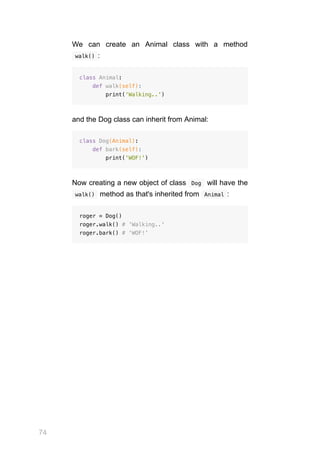
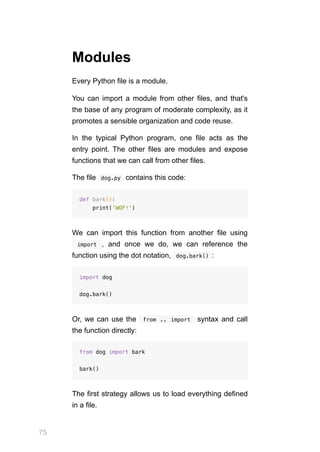
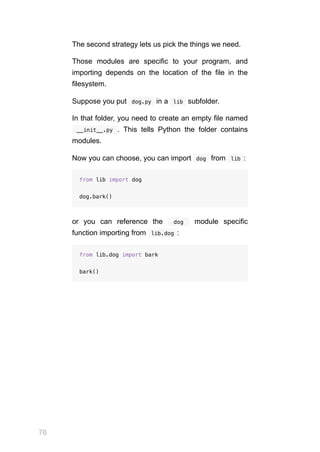
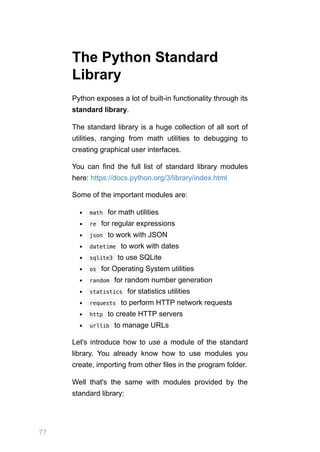
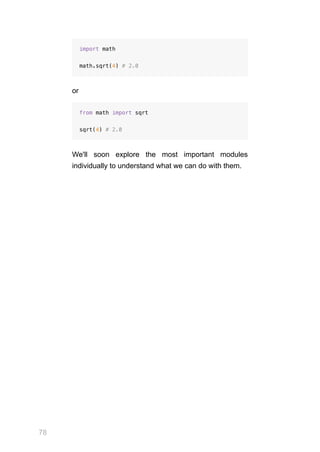




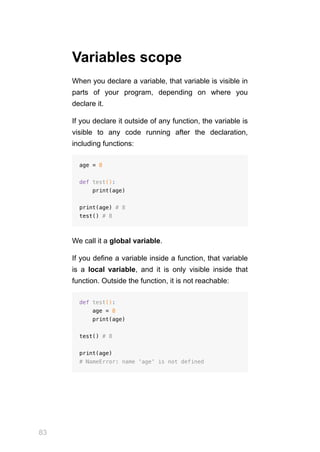
![84
Accept arguments from
the command line
Python offers several ways to handle arguments
passed when we invoke the program from the
command line.
So far you've run programs either from a REPL, or
using
python <filename>.py
You can pass additional arguments and options when
you do so, like this:
python <filename>.py <argument1>
python <filename>.py <argument1> <argument2>
A basic way to handle those arguments is to use the
sys module from the standard library.
You can get the arguments passed in the sys.argv
list:
import sys
print(len(sys.argv))
print(sys.argv)
The sys.argv list contains as the first item the name
of the file that was ran, e.g.
['main.py'] .](https://image.slidesharecdn.com/python-handbook-220701181500-e6d7d68d/85/python-handbook-pdf-85-320.jpg)

![86
You can set an option to have a specific set of values,
using
choices :
There are more options, but those are the basics.
And there are community packages that provide this
functionality, too, like Click and Python Prompt Toolkit.
➜ python python program.py
usage: program.py [-h] -c color
program.py: error: the following arguments are requi
parser.add_argument('-c', '--color', metavar='color
➜ python python program.py -c blue
usage: program.py [-h] -c color
program.py: error: argument -c/--color: invalid choi](https://image.slidesharecdn.com/python-handbook-220701181500-e6d7d68d/85/python-handbook-pdf-87-320.jpg)




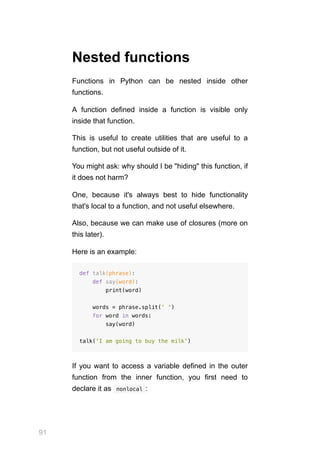

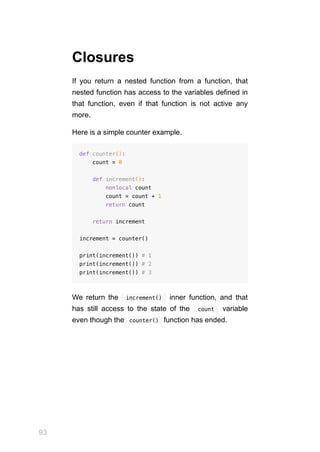














![108
List comprehensions
List comprehensions are a way to create lists in a very
concise way.
Suppose you have a list:
numbers = [1, 2, 3, 4, 5]
You can create a new list using a list comprehension,
composed by the
numbers list elements, power 2:
numbers_power_2 = [n**2 for n in numbers]
# [1, 4, 9, 16, 25]
List comprehensions are a syntax that's sometimes
preferred over loops, as it's more readable when the
operation can be written on a single line:
numbers_power_2 = []
for n in numbers:
numbers_power_2.append(n**2)
and over
map() :
numbers_power_2 = list(map(lambda n : n**2, numbers)](https://image.slidesharecdn.com/python-handbook-220701181500-e6d7d68d/85/python-handbook-pdf-109-320.jpg)
